| All Artists: Eduard Tubin, Neeme Järvi, Bergen Musikselskabet "Harmonien", Bergen Philharmonic Orchestra, Gothenburg Symphony Orchestra Title: Tubin: Symphony No 9; Symphony No 4; Toccata Members Wishing: 0 Total Copies: 0 Label: Bis Release Date: 11/23/1992 Album Type: Import Genre: Classical Styles: Historical Periods, Modern, 20th, & 21st Century, Symphonies Number of Discs: 1 SwapaCD Credits: 1 UPCs: 750582007224, 7318590002278 |
Search - Eduard Tubin, Neeme Järvi, Bergen Musikselskabet "Harmonien" :: Tubin: Symphony No 9; Symphony No 4; Toccata
 | Eduard Tubin, Neeme Järvi, Bergen Musikselskabet "Harmonien" Tubin: Symphony No 9; Symphony No 4; Toccata Genre: Classical
|
Larger Image |
CD Details |
CD ReviewsAn unknown masterpiece! 09/10/1999 (5 out of 5 stars) "Every once in a while, a great by comes around. This is one of those times. The Tubin 4th Symphony (subtitled "Sinfonia Lirica") can stand next to any Symphony by, say, Hanson, Sibelius, Vaughan-Williams, or Nielsen. (I daresay it's better than a lot of some of these composers on their off days). This large Symphonic work is built on a few, Gregorian chant-like melodies that permeate the piece like the air it breathes. The results are astonishing: The first movement lays down the themes that are to be explored with a great deal of finesse and power. The second movement is reminiscent of Ravel's 'Tombeau de Couperin', but with a choice overlay of chromatic melancholy. The third movement begins with a glorious, soaring version of the first movement's theme, and ends with a heartbreaking violin solo. The last movement is optimistic, almost as if the clouds of the previous movements have been lifted. All of the previous themes appear, all transfigured into triumph. This is music to sail by.You don't hear Tubin played much in concert halls. What a pity: I'll bet the Fourth Symphony would elicit standing ovations from any audience. This performance is a good one, but there ought to be more. Listen to this CD, and then send it to your local Orchestra conductor. Better buy 2 copies, since you'll probably not want to give it up." OH God! What a sense of refreshment! David A. Hollingsworth | Washington, DC USA | 10/23/1999 (5 out of 5 stars) "After the stormy and dramatic First and Second Symphonies and the heroic yet defiant Third Symphony, The Fourth Symphony "Sinfonia Lyrica" (1943, revised in 1978) of Eduard Tubin (1905-1982) is a laid back "for a change" type of piece (like Sir Arnold Bax's Third Symphony of 1929). The Symphony is peaceful, a premonition of spring, with optimism and sprinkles of heroism embetted throughout the otherwise beautiful and appealing score. Structurally, the work is the first and only symphony with a four movement format.Unlike the Tubin's Eighth Symphony, the Ninth Symphony "Sinfonia Semplice" (1969) has somewhat a more relaxed communicative expressionism and structure (even more so than Nielsen's Sinfonia Semplice (Sixth Symphony)). The symphony is in two movements with the lyrical, assessible side permeating throughout. Only the Toccata, the third work of this disc, do we witness greater energy and intensity.The performances were well done, especially of the Bergen Philharmonic (in Norway). The orchestra demonstated pure admiration for the work and its great Estonian composer. The Gothenburg Symphony orchestra was not far behind in terms of performing Tubin's Ninth Symphony out of admiration. I must hope for further performances and recordings of Tubin's works in general. To ignore them would be baffling! Recommendable!!" Can't get enough David A. Hollingsworth | 06/15/2000 (5 out of 5 stars) "The fourth symphony is one of those rare works that just keeps getting better with repeated listening. Well played, well recorded. This is one of the great symphonies of the 20th Century."
|

 Track Listings (7) - Disc #1
Track Listings (7) - Disc #1